The FanSided MLB Site Experts collaborated on an offseason simulation by acting as the GM of our respective teams. What moves did the Boston Red Sox make?

Have you ever wondered what it would be like to act as the general manager of the Boston Red Sox? That’s an opportunity I was able to experience by participating in FanSided’s 2017 MLB Winter Meetings.
The Site Experts from each of the MLB FanSided sites banded together to conduct a simulation of the offseason. Each Site Expert acted as faux GM of their respective site to bid on free agents, negotiate trades and manage the payroll.
The official rules of this simulation were outlined in the announcement of the FanSided Winter Meetings last week, but the gist of it is that we were required to adhere to the current 40-man roster as of when the simulation began as a starting point. We were also limited to staying within 15 percent of last season’s Opening Day payroll, according to COTS.
The Red Sox Opening Day payroll in 2017 was just north of $197 million. Add 15 percent to that total and we get an unofficial salary cap of $226 million. While Dave Dombrowski isn’t limited to the same budget, it’s unlikely Boston will go more than $40 million over the luxury tax threshold, which would subject them to the steepest penalties for non-repeat offenders. Therefore, the cap we’re working with is a fair estimate of what the team is expected to spend this winter.
I entered this simulation prioritizing a power threat to anchor the Red Sox lineup. Boston’s roster is set at most positions but they desperately need to add some punch to an offense that finished last in the league in home runs this year. I explored both free agency and trade options, ultimately coming away with a player who adequately fills that need.
Which slugger did the Red Sox add in this simulation and who else was considered? Let’s break down the moves and discussions that occurred during the FanSided Winter Meetings.
